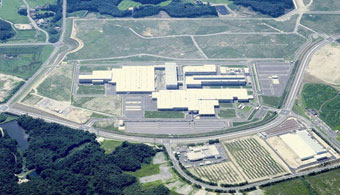
OHIRA, Japan – Going against industry trends to shift production outside Japan, Central Motor, a Toyota subsidiary, officially opened a new car plant last month in this community of 5,000 in northeastern Japan.
Central, one of Japan’s smallest car makers, is betting introduction of a host of cost-saving processes and technologies will enable it to overcome the impact of the strong yen that has hit Toyota harder than other domestic OEMs.
The new plant, when fully up and running, will have capacity to build 120,000 compact cars. It is starting with Yaris production for North America and the Middle East, but in April will add output of the Corolla for Japan.
Central currently is finalizing preparations to shift Corolla production from its 50-year-old Sagamihara plant west of Tokyo, which subsequently will be shuttered.
The Ohira plant, located 20 miles (32 km) north of Sendai, the region’s largest city, is built on a 108-acre (43-ha) site against the backdrop of the picturesque Ou Mountain range in Miyagi prefecture.
It has 22 acres (9 ha) under roof, including stamping, painting, welding, plastic molding and general assembly shops. Most components come from Aichi, Toyota’s home base.
Inside the plant’s walls, Central constructed a temporary floor above the main floor in the general assembly shop, where it installed the operation’s skillet-type conveyor system that eliminates the need for overhead carriers and the heavy steel structure needed to hang them.
![<link rel="stylesheet" href="http://subscribers.wardsauto.com/galleries/files/lightbox.css" type="text/css" media="screen" />
<script src="http://subscribers.wardsauto.com/galleries/files/prototype.js" type="text/javascript"></script>
<script src="http://subscribers.wardsauto.com/galleries/files/scriptaculous.js?load=effects" type="text/javascript"></script>
<script src="http://subscribers.wardsauto.com/galleries/files/lightbox.js" type="text/javascript"></script>
<p><a href="http://subscribers.wardsauto.com/galleries/2011/CENTRAL-1.jpg" rel="lightbox[plants]" title=" Overhead of Central’s plant in Ohira.">Photo Gallery</a></p>
<a href="http://subscribers.wardsauto.com/galleries/2011/CENTRAL-2.jpg" rel="lightbox[plants]" title="Entering Central’s new Ohira facility."></a>
<a href="http://subscribers.wardsauto.com/galleries/2011/CENTRAL-3.jpg" rel="lightbox[plants]" title="Ohira plant’s welding line."></a>
<a href="http://subscribers.wardsauto.com/galleries/2011/CENTRAL-4.jpg" rel="lightbox[plants]" title="Floor pan moves down welding line."></a>
<a href="http://subscribers.wardsauto.com/galleries/2011/CENTRAL-5.jpg" rel="lightbox[plants]" title="Trim line at Ohira plant."></a>](http://subscribers.wardsauto.com/images/2011/03/Central-Motors.jpg)
Other cost-cutting measures include use of less expensive lift-assist devices, rather than robotics, for the installation of seats, instrument panels, windshields and tire-and-wheel assemblies. Placement of cars side by side on the conveyor, rather than end to end, shortened line length by 35%, also saving money.
In the paint operation, introduction of a 3-layer wet system eliminates the need for one of three ovens, reducing shop size and cost, while lowering carbon-dioxide emissions.
Only 20% of suppliers are located near the plant. Among them: Toyota Boshoku (seating), Toyota Motor Tohoku (braking and suspension parts) and Kanto Auto Works (stamping parts). Central hopes to raise the number to 40% over the next few years.
Still unclear is how the operation will contribute to Toyota’s bottom line, because Toyota has 1 million units of excess capacity in Japan and compact cars like the Yaris are not profitable to export.

Toyota is projecting a ¥420 billion ($5 billion) operating loss in the current fiscal year ending March 31, with exchange-rate losses accounting for 80% of that total.
Confusing matters, only 36% of Toyota and Lexus vehicles – nearly 850,000 units through the first nine months of the current fiscal year – are produced by Toyota in Japan. Another 1.5 million come from affiliated manufacturers such as Central.
Unlike Toyota, all affiliated manufacturers are profitable, as are all major suppliers.
Toyota Executive Vice President Atsushi Niimi, who attended the plant’s official Job One on Feb. 16 (the plant started operations in mid-January), says Central’s capital investment was 40% less than the cost of a conventional assembly plant.
“Manufacturing accounts for 20%-30% of total vehicle cost, with facility investment representing around half of that amount,” he says. “This means that (a 40% reduction in facility investment) results in a 15% lower per-vehicle cost.”
Central declines to disclose its outlay for the plant, although when it first announced plans to build the facility in October 2007, one year before the Lehman Brothers bankruptcy triggered a global recession, Japanese media reports mentioned a ¥47 billion ($573 million) price tag. The final amount almost certainly is less.
Against this backdrop, Miyagi prefecture offered an incentive package of more than ¥3 billion ($36 million) to induce the Toyota subsidiary to move to the region, while wage levels for Central’s 1,500-person workforce are 20% below Toyota’s.
Analysts believe that by proceeding with the project despite the downturn in its business, Toyota will enhance its brand in the region. Kanto Auto Works, another affiliated manufacturer, opened a new assembly plant there six years ago, and combined Kanto and Central capacity now stands at 420,000 units.




